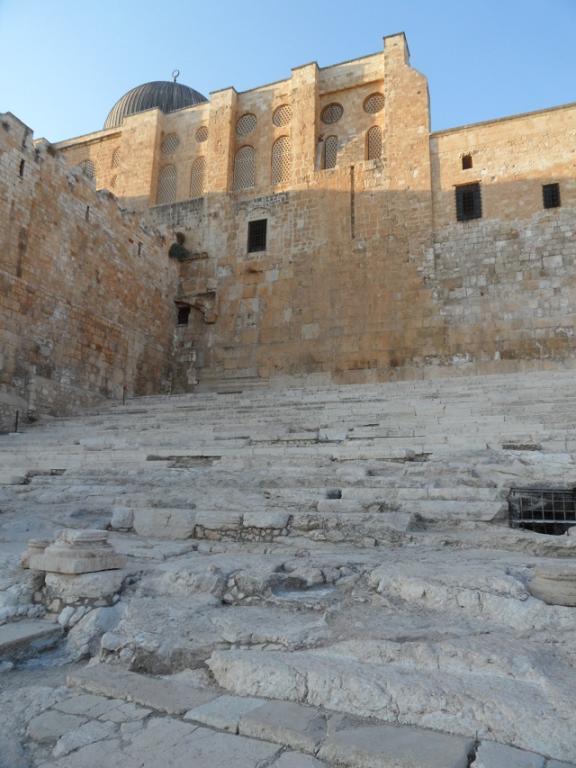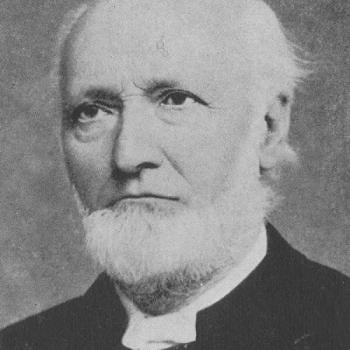Holy Places, Relics, and the Sacramental Principle

Steps leading up to the temple; on the south side of the temple mount: where Jesus could quite likely could have walked. Photograph by my wife Judy Armstrong: 31 October 2014
*****
[excerpt from my book, Footsteps That Echo Forever: My Holy Land Pilgrimage, written in our hotel room, on a rainy day in Jerusalem: 2:30 PM local time, 31 October 2014]
*****
On the south side of the temple mount nearby is a spectacular archaeological park. It has steps going up to what used to be Herod’s temple, that Jesus and the disciples (and Mary and Joseph) almost certainly walked on. I discerned that a large Protestant group was nearby, being lectured to: probably by a pastor. I’m sure he taught good things, but I was struck by the difference of approach. They observed the stairs, but mainly wanted to sit and hear a mini-sermon (which is the focus of Protestant church worship as well).
My interest and desire, on the other hand, was to actually walk where Jesus walked, as much as I could: to physically touch the holy items: in this instance, steps (with my ring as well). This is Catholic sacramentalism: an important and supernatural area of Christianity that is largely lost to many Protestants, but retained by Catholicism and Orthodoxy.
It’s not a complicated notion, and shouldn’t be controversial at all. God wills to convey grace to us by means of physical things. There are such things as holy space, holy things, and particularly holy people (saints). From this follows the theology of relics, sacraments, sacramentals, eucharistic adoration, shrines and pilgrimages, holy cities (Jerusalem), the Holy Land, and sainthood.
I actually would have acted pretty much the same way as a Protestant. I would have wanted to walk the steps, simply because Jesus did. I would have denied that grace was literally received (thus, no touching of my ring). It would have been more of an awe-inspired, reverential, “am I really here?” sort of thing. This is not too far from the truth, but it still lacks the full sacramental understanding that God intended for His followers to possess.
In the fascinating archaeological excavations south of the temple mount (all done since 1968), there are ruins going back even to the first temple period (c. 980 to 586 B. C.), and many ritual baths. Jesus, the holy family, and the disciples would have used some of these. This is all the “stuff” of “pilgrimage” and holy place and space. I’ve always had historical and archaeological / architectural interest in all these things. But now the additional spiritual / theological elements are also part of it.
If God were so opposed to the physical, as many seem to think, or if spirit were supposedly “superior” (as the Gnostics and other heretics taught), why, then, wouldn’t He have us continue as mere spirits for eternity? But He doesn’t do that. He created a physical world. He became a man Himself. He taught His chosen people that they lived in a holy city with a holy temple and holy days. He told Moses to remove his shoes because he was on holy ground.
Jesus redeemed the world in the physical acts of His passion and crucifixion, saving us by His (physical) blood. He rose bodily from the dead and ascended bodily to heaven from a real physical rock on a real mountain (that I have now seen and touched). He returned physically after His Resurrection and ate fish with the disciples, by a real lake with real water (I sat on the rock where that happened, too), and had flesh and bones. He even retained His wounds for all eternity.
All that, yet some Protestants want to sneer at and look down on unsophisticated, allegedly spiritually “dumb” Catholics like myself, who want to walk on stairs where Jesus walked and to touch wedding rings to holy places? They just don’t get it. The last “laugh” (to put it somewhat crudely) is (or will be) on them. But maybe some of you reading this account will start to grasp these (quite biblical) aspects of traditional Christianity. That is one of my hopes for this volume.
*****
Meta Description: Reflections on holy places & sacramentalism, relating to literally walking in places where Jesus walked (my trip to Israel in 2014).
Meta Keywords: biblical archaeology, holy items, Holy Land, holy places, Israel, Jerusalem, pilgrimage, presence of God, sacred space, temple, temple mount, Old City of Jerusalem, temple steps













